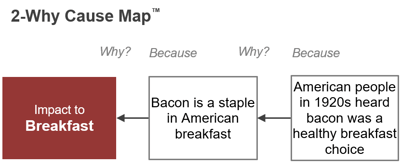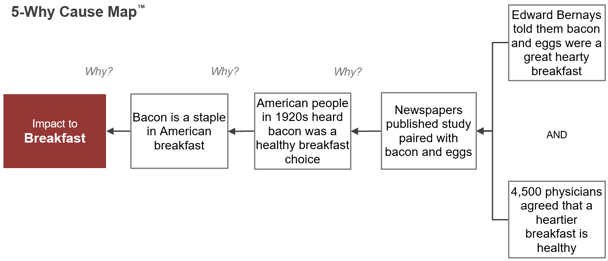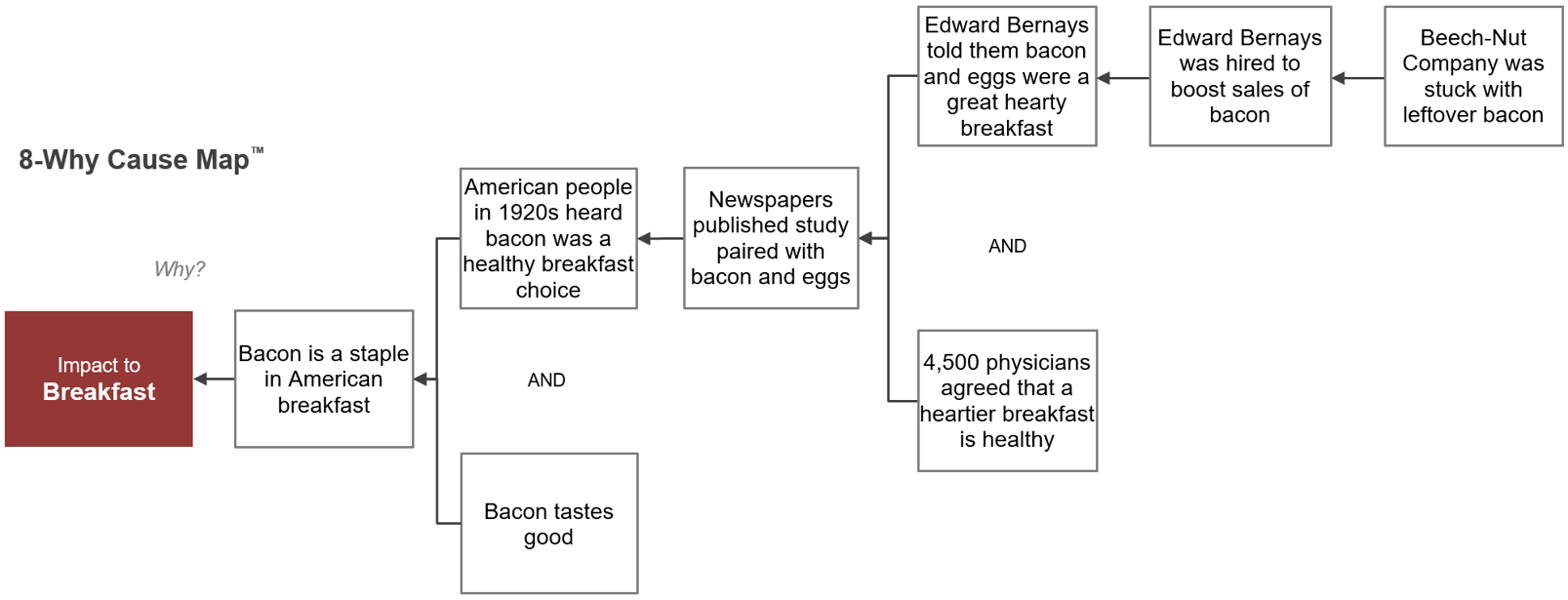The Classic Bacon Breakfast
Most Americans know bacon as a staple for a hearty breakfast. While people may not have bacon for breakfast all the time, there is a high likelihood that bacon is part of at least one breakfast per month for the average American. Not only is it served at almost every breakfast restaurant, but it’s a meat option in most breakfast meals including omelets, breakfast sandwiches, and even crumbled on top of doughnuts. In fact, the average American eats 18 pounds of bacon each year and 70 percent of that is consumed at breakfast.
Many Americans don’t know that bacon was kicked out of the breakfast scene during the industrial revolution. It wasn’t until the late 1920s that bacon made a comeback, and the reason for its monumental return is probably not one you would guess. In this blog, we will use cause-and-effect analysis to study bacon’s rise in popularity as a breakfast item in the US.
Bacon’s Rise to Fame
In the early 1920s, the typical American breakfast consisted of coffee and maybe a slice of toast. Breakfast was typically light, without much substance. It was not the most important meal for many people.
During this time, Beech-Nut Packing Company, which manufactured items such as candy, peanut butter, jam, chewing gum, and coffee, was growing in size. The company’s most important products, at least for this story, were pork products – more specifically – bacon. Beech-Nut noticed its bacon sales were stagnating while the sale of the rest of its pork products was growing. This translated to a lot of leftover bacon. Rather than throw it all away, they decided that they needed to find a way to increase sales. This dilemma brought them straight to Edward Bernays.
Edwards Bernays is widely regarded as the father of public relations and propaganda. He was the nephew of Sigmund Freud and used his uncle’s theories on the concept of self in his campaigns to capitalize on people's unconscious needs. He created the pancake breakfast for President Coolidge’s reelection campaign, destigmatized women smoking, popularized the use of disposable cups, and perhaps most impactfully, his work led to the overthrow of a democratically elected Guatemalan president. For this blog, though, let’s focus on the more fun topic of bacon for breakfast.
When Beech-Nut Packing Company reached out to Bernays, he identified the return to breakfast as a great opportunity to expand the demand for bacon. Bernays knew that the American public was responding well to “health food” campaigns and decided that he needed to make bacon fit into that trend.
To accomplish this feat, Bernays talked to the in-house doctor. (Yes, his PR firm had an on-staff doctor.) He asked the doctor if it is healthy to start the day with more energy, and the doctor confirmed that it was a good choice. Bernay then asked if a big, hearty breakfast would give you more energy, which the doctor again confirmed. Finally, Bernays asked if bacon and eggs would constitute a big, hearty breakfast. The doctor confirmed that it would.
With this information, Bernays told the doctor to reach out to 5,000 physicians to get them to confirm that eating a heartier breakfast would give people more energy than a light breakfast. In all, 4,500 doctors wrote back agreeing with the in-house doctor.
Bernays sent the words of these 4,500 pediatricians to the American media. The next couple of days, the headlines in all the newspapers read “4,500 physicians urge Americans to eat heavy breakfasts to improve their health,” with many of the articles using bacon and eggs as the prime example. The American people read these headlines and bacon, once again, became a breakfast staple.
Utilizing Cause-and-Effect Analysis With a Cause Map™ Diagram
Now that we have the story and background information, let’s use our evidence-based cause-and-effect analysis to help understand the story. While a timeline moves forward in time, a Cause Map diagram works backward through time asking ‘why’ questions to truly capture the cause-and-effect relationships.
For an incident investigation, you would identify the company goal(s) impacted by the incident. For the purpose of this light-hearted blog, we start our Cause Map diagram with the impact to breakfast. Why was breakfast impacted? Because bacon is now a breakfast staple. Why? Because Americans in the 1920s were told by doctors that it was a healthier choice than a light breakfast. These 'why' questions create our first cause-and-effect relationships with the effect on the left and the causes on the right.
As we dive into more serious cause-and-effect relationships, we continue to ask “why” questions. Why did the American people in the 1920s believe bacon was a healthier breakfast choice than a lighter option? Because newspapers published that 4,500 physicians were urging Americans to eat a breakfast of bacon and eggs to improve their health.
Why did newspapers publish that 4,500 physicians were urging Americans to eat a breakfast of bacon and eggs to improve their health? Because Edward Bernays told the newspapers that 'bacon and eggs' is a perfect hearty breakfast when he sent the newspapers the results of a manufactured study AND the study showed that the physicians agreed that a heartier breakfast was healthier than a light breakfast.
Did you catch that there was an “AND” in that cause? There is always more than one cause for an effect. If you are looking to expand your investigation, using the “AND” relationships will add more branches and allow for a deeper understanding of all the causes.
Following a Causal Path
In an investigation, it is often easier to follow one causal path at a time and loop back later to the others. Let’s focus on the top path and continue asking our why questions. Why did Edward Bernays tell the newspapers that bacon and eggs are the perfect hearty breakfast when he sent the newspapers the results of a manufactured study? Because he was hired by the Beech-Nut Company to help increase the sale of bacon. Why did the Beech-Nut Company hire Bernays to help with bacon sales? Because they were stuck with leftover bacon. Let’s look at the visual diagram to bring it all together.
Now you know that bacon is a staple American breakfast food because of an Edward Bernays PR campaign for the Beech-Nut Company that used somewhat misguided physician opinions and the media to change public opinion of a failing product. As a bacon lover myself, I just have to add one last cause that I believe truly helped bacon become what it is today. Bacon tastes good, so let's just add that to the Cause Map diagram too.
If you enjoyed this fun Cause Mapping® root cause analysis and the visual displays of cause-and-effect analysis, join us for one of our Public Cause Mapping Root Cause Analysis Workshops. These workshops provide a deep dive into evidence-based root cause analysis and show how you can improve your incident investigations. We offer both online and in-person options so you can have fun traveling for training or even gain valuable knowledge from the comfort of your own home.














